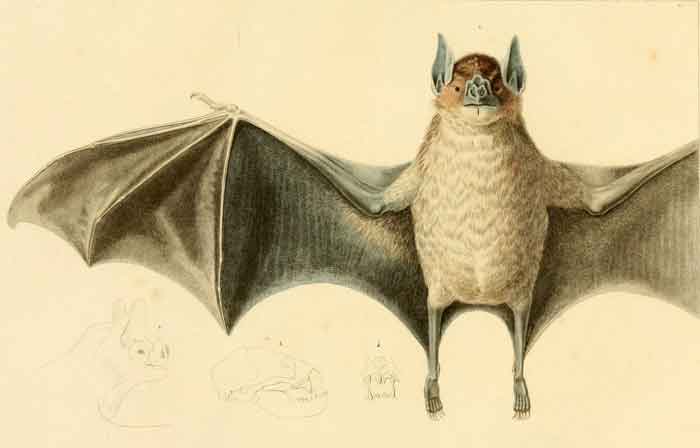
Desmodus rotundus (Information about this image)
Superregnum: Eukaryota
Cladus: Opisthokonta
Regnum: Animalia
Subregnum: Eumetazoa
Cladus: Bilateria
Cladus: Nephrozoa
Cladus: Deuterostomia
Phylum: Chordata
Subphylum: Vertebrata
Infraphylum: Gnathostomata
Superclassis: Tetrapoda
Classis: Mammalia
Subclassis: Theria
Infraclassis: Eutheria
Ordo: Chiroptera
Subordo: Microchiroptera
Superfamilia: Noctilionoidea
Familia: Phyllostomidae
Subfamilia: Desmodontinae
Genus: Desmodus
Species: Desmodus rotundus
Name
Desmodus rotundus (E. Geoffroy, 1810)
Type locality: Paraguay, Asuncion.
Synonyms
* cinerea D'Orbigny, 1834
* dorbignyi Waterhouse, 1838
* ecaudatus Schinz, 1821
* fuscus Burmeister, 1854
* mordax Burmeister, 1879
* murinus Wagner, 1840
* rufus Wied-Neuwied, 1824
References
* E. Geoffroy, 1810. Ann. du Museum National d'Histoire naturelle Paris, 15: 181.
* Conservation status: IUCN link: Desmodus rotundus (Least Concern)
* Desmodus rotundus on Mammal Species of the World.
Mammal Species of the World: A Taxonomic and Geographic Reference, 2 Volume Set edited by Don E. Wilson, DeeAnn M. Reeder
Distribution
* Uruguay, North Argentina, Paraguay, Bolivia, and North Chile north to Sonora, Nuevo Leon and Tamaulipas (Mexico)
* Margarita Island (Venezuela)
* Trinidad
Vernacular names
Internationalization
Česky: Upír obecný
Deutsch: Gemeiner Vampir
English: Common Vampire Bat
Español: Desmodus rotundus
Français: Desmodus rotundus
עברית: ערפד מצוי
日本語: ナミチスイコウモリ
Lietuvių: Didysis vampyras
Nederlands: Gewone vampier
Polski: Wampir zwyczajny
Português: Morcego-vampiro
Runa Simi: Wiruchu
Suomi: Isoverenimijä

The Common Vampire Bat (Desmodus rotundus) is a species of vampire bat. They have burnt-amber colored fur on their backside while soft and velvety light brown fur covers their belly. They have large pointy ears and a flat leaf-shaped nose. Their babies use tiny thumbs in the middle of the wing to cling on the mother’s furry belly. Vampire bats are about 9 cm (3.5 in) long and have a wingspan of 18 cm (7 in). They commonly weigh about 57 grams (2 oz), but that can double after just one feeding.[1]
Feeding
Vampire bats feed on the blood of large birds, cattle, horses, pigs, dogs and many other animals including humans. However, they don’t suck the blood directly from their prey, they let it flow from the wound first before lapping it up.
The Common Vampire Bat is a specialist species. The front teeth, lips and tongue are highly specialized, with the former used to trim the surrounding fur of the host, acting like scissors. Then a piece of skin is removed by the razor-sharp V-shaped front teeth, much like using a spoon to scoop ice cream out of a cup. During this process the animal's saliva, which contains an anticoagulant named after vampire bat Desmoteplase, is released and the resulting wound bleeds freely, enabling the vampire to feed using grooves in its lower lip and under its tongue. The grooves form a straw-like structure enabling the bat to suck the blood rather than lapping it.
Behavior
The vampire bat is one of the few known bats capable of walking, jumping and hopping. This is accomplished by folding its wings in such a way that the animal literally walks on its thumbs.[2] This behavior is important because it permits the bat to stealthily maneuver on the ground and host. Vampires climb to get to places on the host, such as shoulders, underside of the tail and teats and soft tissue near the hoof to get to the unique spot. Often they will return night after night to the same animal (particularly tethered farm animals), so they just have to lift the scab from previous visits to get more blood. It is speculated that before the introduction of domesticated animals, vampires fed upon a wide variety of animals including opossums, armadillos, raccoons, snakes, birds, monkeys, and so forth.[3]
Worker holding Common Vampire Bat. Trinidad, 1956. Courtesy of the Greenhall's Trust - WI
Footnotes
1. ^ [1]
2. ^ A.M. Greenhall and U. Schmidt, editors. 1988. Natural History of Vampire Bats, CRC Press, Boca Raton, Florida. ISBN 0849367506; ISBN 978-0849367502, pp. 72-79.
3. ^ A.M. Greenhall and U. Schmidt, editors. 1988. Natural History of Vampire Bats, CRC Press, Boca Raton, Florida. ISBN 0849367506; ISBN 978-0849367502, pp. 114ff.
References
* Barquez, R., Perez, S., Miller, B. & Diaz, M. (2008) Desmodus rotundus In: IUCN 2010. IUCN Red List of Threatened Species. Version 2010.2. www.iucnredlist.org Retrieved on 17 July 2010.
* Greenhall, Arthur M. 1961. Bats in Agriculture. A Ministry of Agriculture Publication. Trinidad and Tobago.
* Greenhall, Arthur M. 1965. The Feeding Habits of Trinidad Vampire Bats.
* Greenhall, A., G. Joermann, U. Schmidt, M. Seidel. 1983. Mammalian Species: Desmodus rotundus. American Society of Mammalogists, 202: 1-6.
* A.M. Greenhall and U. Schmidt, editors. 1988. Natural History of Vampire Bats, CRC Press, Boca Raton, Florida. ISBN 0849367506; ISBN 978-0849367502
* Walker, Steven. 1996. Desmodus. University Editions. Virginia. ISBN 1-56002-637-5
* Riskin, Daniel K. and John W. Hermanson. 2005. Biomechanics: Independent evolution of running in vampire bats. Nature 434: 292-292. Abstract, video.
* Kishida R, Goris RC, Terashima S, Dubbeldam JL. (1984) A suspected infrared-recipient nucleus in the brainstem of the vampire bat, Desmodus rotundus. Brain Res. 322:351-5.
* Campbell A, Naik RR, Sowards L, Stone MO. (2002) Biological infrared imaging and sensing. Micron 33:211-225. pdf.
Retrieved from "http://en.wikipedia.org/"
All text is available under the terms of the GNU Free Documentation License

